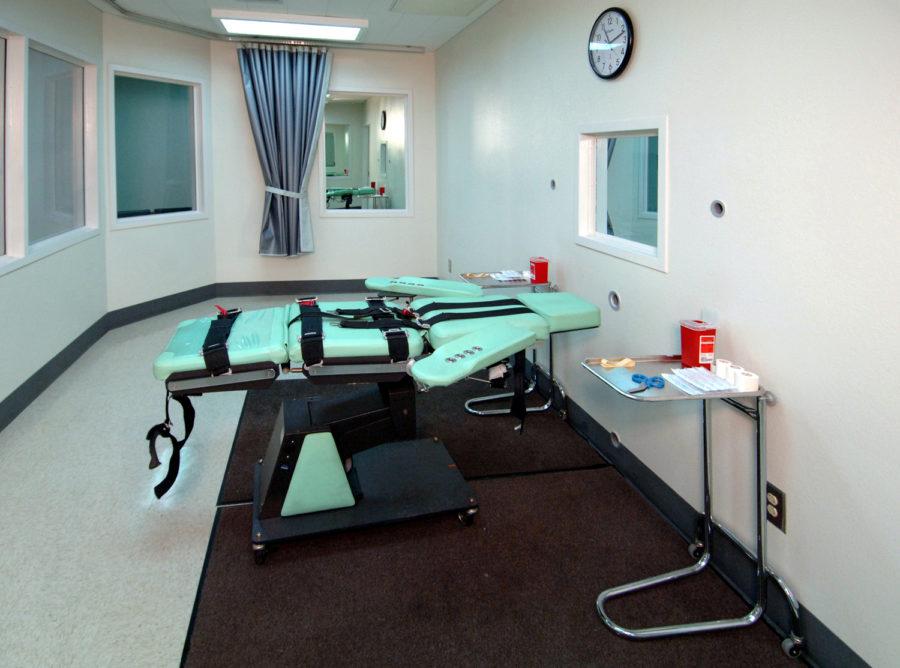Opinion | Time to execute the death penalty
A California prison lethal injection room.
June 4, 2019
New Hampshire overrode Gov. Chris Sununu’s, R-N.H., veto and voted to abolish the death penalty on May 30, making it the 21st state to kill the death penalty in the last few decades. The state’s efforts to end capital punishment have been going on for years.
The United States is one of the few developed countries in which the death penalty is still legal in certain places, despite it being an inhumane and outdated form of punishment. The practice is also expensive, irreversible and ineffective when it comes to curbing criminal offenses. This information has long been known and well-researched. Needless to say, it’s time for other states to follow New Hampshire in abolishing the death penalty.
Pennsylvania is one of the 30 states that still allow execution as a sentence. When Gov. Wolf, D-Pa., announced the moratorium of the death penalty in 2015, he noted that six people had been exonerated from Pennsylvania’s death row that same year. While that number may appear to be shocking, it really isn’t surprising.
According to studies conducted by legal experts, one in 25 people on death row are wrongfully convicted. In other words, 4% of those put to death are innocent. Since 1976, 1,499 people have been put to death in the United States. These statistics suggest that at least 59 of these people were not guilty of the crimes for which they were executed.
Unfortunately, most of the people who are wrongly convicted are never granted liberty. For example, Cameron Todd Willingham was put to death in 2004 for killing his three daughters and then setting his house on fire. He maintained his innocence throughout his entire trial and residence on death row. Evidence has periodically emerged indicating that the fire was likely a complete accident and Willingham was completely innocent. And Willingham’s story is hardly unique. The Death Penalty Information Center has a running list of people who have been executed but were likely innocent.
Despite there being no way to 100% prove the guilt of everyone on death row, some still support capital punishment, insisting that the death penalty can act as a deterrent against other crimes. In other words, people will not commit certain crimes due to the looming fear of possibly being put to death. One of the more famous people to speak to this was former U.S. President Richard Nixon.
“Contrary to the views of some social theorists, I am convinced that the death penalty can be an effective deterrent against specific crimes,” Nixon said after a court ruling in 1973.
But studies conducted in the past decade have shown that social theorists are probably correct. A comprehensive study conducted in 2009 found that 88% of leading U.S. criminologists do not believe that the death penalty is a homicide deterrent. The alternative to the death penalty is a life sentence in prison without parole, which is actually less expensive for the government and taxpayers than carrying out executions. This isn’t due to the cost of the execution itself, but rather the trial leading up to the sentencing.
Capital cases are much more lengthy than cases where the death penalty is not considered. They also cost about four times more in their entirety, according to a study conducted by the Kansas Judicial Council in 2014. The Washington State Bar Association estimates that death penalty cases generate roughly $470,000 in additional costs to the prosecution and defense versus a similar case without the consideration of the death penalty. This estimate does not even take the cost of court personnel into account. According to Richard C. Dieter of the non-partisan DPIC, studies have repeatedly shown that a death penalty trial costs $1 million more than one in which prosecutors seek life without parole.
Even conservatives, who are typically against abolishing the death penalty, have weighed in on the economic threat it poses.
“Forget justice, morality, the possibility of killing an innocent man or any of the traditional arguments that have been part of the public debate over the death penalty,” Ed Barnes, a Fox News reporter wrote in 2010. “The new one is this: the cost of killing killers is killing us.”
All economic concerns pushed aside, there’s still an ethics problem with the execution methods. Until the 1980s when lethal injection was deemed more ethical, the electric chair was the most corporate execution method. The chair was phased out for good reason. In the past, prisoners have needed more than one shock to die completely, and bodies have bled and caught on fire.
But lethal injection is just as unethical as electrocution, if not more than. The actual process happens in a series of three injections — first, an anesthetic to knock the inmate unconscious, and then pancuronium bromide, which paralyzes the muscles. Finally comes the potassium chloride, which stops the heart and kills the inmate. The final two injections are incredibly painful without an anesthetic.
The United States stopped manufacturing the anesthetic drug, thiopental, around 2010. European nations refuse to sell the drug to U.S. government officials because those carrying out executions are not pharmacists or doctors. As a result, states have moved to the drug midazolam to act as the anesthetic.
Midazolam does not have any anesthetic or painkilling properties on its own, though. Even when mixed with other sedatives, the drug is only used in a medical setting for something called “conscious sedation,” which is a type of incomplete anestesia that works for short outpatient procedures, not administering sodium chloride to stop the heart.
Because of this, executions can be extremely painful for inmates, though they cannot express their pain because they are paralyzed. One of the most famous cases of botched execution is Clayton Lockett, an Oklahoma man who was put to death by lethal injection in 2014. The injection needle was not administered properly, and Lockett said the paralysis drug was not injected into his bloodstream. There were no backup drugs on the day of his execution. A report from the execution describes the way in which he “began breathing heavily, writhing on the gurney, clenching his teeth and straining to lift his head off the pillow.”
“People convicted of crimes should not be test subjects for a state’s grisly experiments,” said Antonio Ginatta, U.S. advocacy director at Human Rights Watch, after the execution. “Last night’s botched execution was nothing less than state-sanctioned torture.”
More than 7% of lethal injection executions are botched and 3.15% of executions are botched overall, according to the DPIC. While it’s arguable whether the death penalty itself violates the constitution as an act of cruel or unusual punishment, torturing someone on their deathbed most certainly does violate the Eighth Amendment.
At the end of the day, the death penalty doesn’t benefit anyone. New Hampshire was right to abolish it, and now it’s up to other states to follow its lead and execute the death penalty once and for all.
Leah Mensch is the opinions editor at the Pitt News. She writes mostly about sustainability and social issues. Write to Leah at LEM140@pitt.edu.




